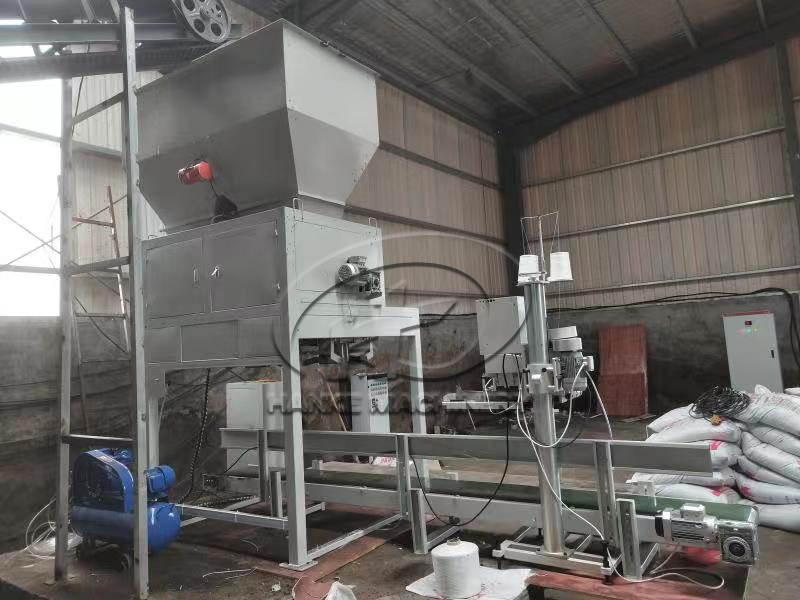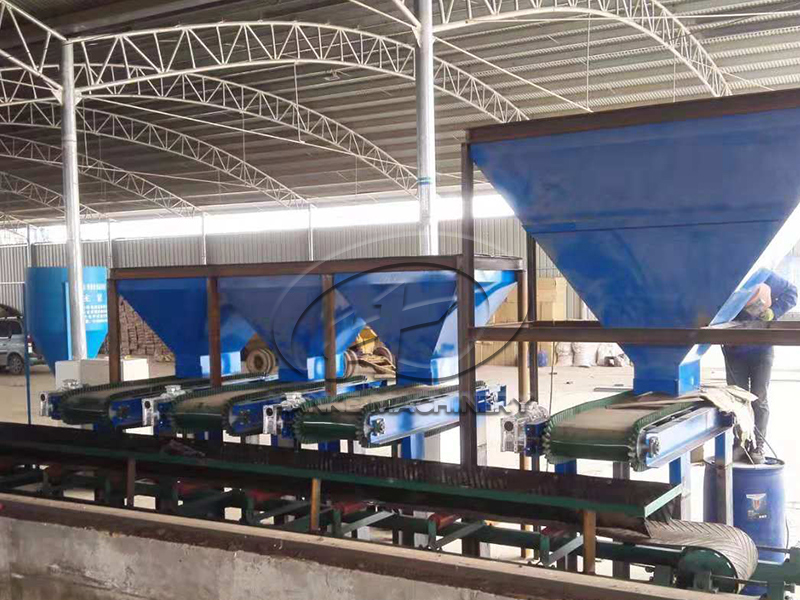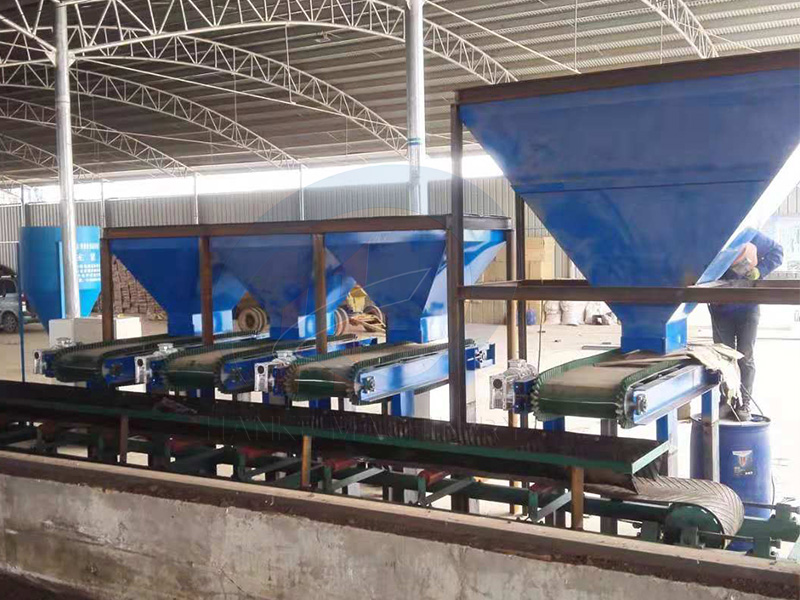 HOME > News > Industry News > What is the cleaning frequency of the loach feed weighing and packaging machine?
HOME > News > Industry News > What is the cleaning frequency of the loach feed weighing and packaging machine? Update time : 2025-09-09 Publisher:Zhengzhou Hanke Machinery
The cleaning frequency of the loach feed weighing and packaging machine should be determined comprehensively based on the equipment usage intensity, feed characteristics (such as moisture and viscosity), dust conditions in the production environment, and industry hygiene standards. The core principle is to "prevent feed from getting moldy due to residue, avoid clogging or corrosion of equipment components, and ensure weighing accuracy and packaging hygiene." The following provides specific frequency standards and operational highlights from three dimensions: daily cleaning, regular cleaning, and special scenario cleaning.
I. Daily Cleaning: A must-do every day to prevent immediate residue buildup.
Cleaning frequency: A basic cleaning must be carried out after each production run (or after the completion of the daily production task), and it is not allowed to be postponed until the next day.
Cleaning reason: The feed for loaches is mostly high-protein pellets or powder, some of which contain oil and binders. If it remains overnight, it is prone to absorbing moisture and forming lumps, and breeding microorganisms. This not only pollutes the feed for the next production but also may clog the discharge port and sensor gaps, affecting the weighing accuracy.
Cleaning Focus and Operations:
1. Cleaning of the blanking system:
Turn off the power of the equipment, remove the hopper and conveyor belt (if removable), and clean the remaining feed powder / pellets with a dry soft brush or compressed air (pressure ≤ 0.6 MPa). Avoid hard scraping to prevent wear on the inner walls of the equipment (especially for stainless steel materials).
If the feed is highly viscous (such as when a starch-based binder is added), the inner wall can be wiped with warm water (≤ 40℃) and neutral detergent, then dried with a dry cloth to prevent rust caused by water residue. (Pay special attention to drying the sensor connection area to avoid moisture affecting accuracy.)
2. Cleaning of the weighing system:
Use a soft brush to clean the residual feed around the weighing sensor and at the bottom of the weighing hopper. Do not directly wipe the sensor with a damp cloth (the sensor is a precision component and moisture can easily cause data drift). If there are stubborn residues, you can dip a small amount of anhydrous ethanol and gently wipe.
3. Sealing / Packaging System Cleaning:
Clean the residual feed on the heating strip and cutting blade of the sealing machine (especially the feed scorch residue that may adhere during heat sealing). Wipe the heating strip with a dry cloth dipped in alcohol to prevent the scorch residue from affecting the sealing performance. If it is film packaging, the film traction roller also needs to be cleaned to avoid film deviation caused by dust.
4. Surface cleaning of equipment:
Wipe the equipment body and operation panel with a dry cloth to remove surface dust and feed debris, keeping the equipment appearance clean. At the same time, check if the buttons on the operation panel are not stuck by foreign objects.

II. Regular Cleaning: Periodic deep cleaning to prevent long-term risks.
Based on the daily operating hours of the equipment (such as 8 hours / 12 hours / 24 hours of continuous production), the regular cleaning frequency is divided into once a week and once a month. The core is to clean the hard-to-reach dead corners and easily fouled components on a daily basis.
1.Weekly deep cleaning (for production scenarios of 8-12 hours per day)
Disassembly of the feed pipe and valve: Remove the joint of the feed pipe, clean the inner wall of the pipe with compressed air or a soft brush to remove any remaining feed (especially in the bends where it tends to accumulate), and check if there is any feed adhering to the valve sealing ring. If so, wipe it with warm water and let it dry to prevent the sealing ring from aging and losing its effectiveness.
Weighing hopper and discharge door: If there is a side cover on the weighing hopper, open it. Clean the corners inside the hopper and the gaps of the discharge door seal strip. If the seal strip is worn or has hard adherents, clean it in time and check the sealing performance (to prevent material leakage and affect the weighing accuracy).
Conveyor belt rollers: Clean the surface of the idler rollers and drive rollers beneath the conveyor belt. If there is an accumulation of feed powder, it may cause the conveyor belt to slip or deviate. Wipe them with a dry cloth and then check if the rollers rotate smoothly.
2. Monthly comprehensive cleaning (applicable to all production intensities, with a focus on anti-corrosion and anti-clogging)
Electrical control cabinet cleaning: After power off, open the cabinet door and use dry compressed air (or the cold air setting of a hair dryer) to clean the dust inside the cabinet (especially the dust on the contactors and the heat sinks of the frequency converters to prevent overheating faults). It is strictly forbidden to clean electrical components directly with a damp cloth or water.
Pneumatic component cleaning: If the equipment contains pneumatic components such as cylinders and solenoid valves, clean the dust on the surface of the cylinder piston rod, and check whether there is any air leakage at the air pipe joints. A small amount of special lubricating grease can be applied to the surface of the piston rod (to prevent rust and extend the service life of the sealing parts).
Clean the equipment base and the ground: Remove the feed debris under the equipment base and in the ground crevices (these areas are often overlooked, and long-term accumulation can attract insects, rats or breed mold). Use a broom to sweep and then wipe the ground with a wet mop to keep the production environment dry.
III. Special Scene Cleaning: Immediate Handling to Prevent Equipment Damage
When the following situations occur, the machine must be stopped immediately for cleaning and must not be delayed:
When the characteristics of the feed change: If switching from regular pellet feed to high-moisture (moisture content > 15%), high-fat (with added fish oil, etc.) or feed containing trace additives (such as vitamin premixes), the feeding system and weighing hopper must be thoroughly cleaned to prevent cross-contamination between different feeds and to avoid clogging of the pipelines by highly viscous feed.
When the equipment gives an abnormal alarm: If faults such as "large weighing accuracy deviation", "slow discharging speed", and "improper sealing" occur, the machine should be stopped first to clean the corresponding parts (such as blocked discharging ports, accumulated materials on the weighing sensor, and sticky materials on the sealing machine), and then other possible causes of the faults should be investigated.
When production is interrupted for more than 24 hours: If the equipment stops production for more than one day, all parts that come into contact with the feed must be thoroughly cleaned before restarting. Especially in the hot and humid summer environment, residual feed is prone to mold in a short time. After cleaning, the equipment should be run idle for 10 to 20 minutes to confirm that it is operating normally before feeding.
IV. Cleaning Precautions (Key Taboos, Avoiding Operational Errors)
1.Safety First: Before cleaning, the main power supply and gas source (if any) of the equipment must be turned off. It is strictly prohibited to clean while the equipment is powered on or under pressure, especially the electrical components and weighing sensors, to prevent electric shock or incorrect operation of the equipment.
2. Tool Selection: Do not use hard steel brushes, blades or other sharp tools to clean the inner walls of the equipment to prevent scratching the stainless steel surface (scratches can easily retain feed and accelerate corrosion); when cleaning damp parts, use soft cloth or sponge to avoid water seeping into the equipment.
3. Drying Principle: All components that come into contact with feed (such as the feeding hopper, weighing hopper, and conveyor belt) must be thoroughly dried or wiped dry after cleaning. Especially for components washed with water, it is strictly prohibited to start the equipment with water remaining (to prevent electrical short circuits, moisture damage to sensors, and rusting of components).
By adhering to the above-mentioned cleaning frequency and operational norms, the service life of the loach feed weighing and packaging machine can be effectively prolonged (usually by 2 to 3 years), while ensuring the accuracy of feed packaging (with an error controlled within ±0.2%) and hygiene and safety, and avoiding feed deterioration or equipment malfunctions caused by residues.

see details +

see details +

see details +

see details +

 Tel:+86 17319777703
Tel:+86 17319777703
 E-mail:hkautomaticpack@foxmail.com
E-mail:hkautomaticpack@foxmail.com
 Address:Xingyang City, Zhengzhou City, Henan Province.
Address:Xingyang City, Zhengzhou City, Henan Province.
Privacy Policy Copyright © Zhengzhou Hanke Machinery Equipment Co., Ltd Co., Ltd.